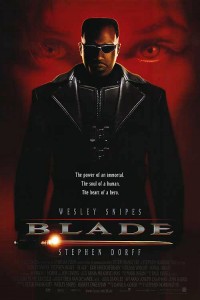In a multi-part series, Comic Book Film Editor William Gatevackes will be tracing the history of comic book movies from the earliest days of the film serials to today’s big blockbusters and beyond. Along with the history lesson, Bill will be covering some of the most prominent comic book films over the years and why they were so special. This time, we’ll talk about how Blade was the true start of Marvel’s dominance of the comic book film.
One way to look at it, he could be the answer to “What if Shaft hunted vampires?” Or it could have very well been a counterpoint to Blacula, which hit theaters the year before. You can make any theory you want, but it seems like Blade’s first appearance in 1973’s Tomb of Dracula #10 played off the popular Blaxploitation trend of the day. It is ironic that a character inspired by a film genre would be the adaptation that would jump-start Marvel’s mastery of the film box office.
 The comic book Blade was created by Marv Wolfman and Gene Colan to be an adversary of Dracula. He was the son of a woman who was attacked by a vampire while giving birth to Blade. This bite passed on certain abilities to Blade, such as not being susceptible to vampires yet being attuned to their genetic makeup, therefore able to track them. Other than that, he was a highly-trained martial artist and fighter with no superpowers.
The comic book Blade was created by Marv Wolfman and Gene Colan to be an adversary of Dracula. He was the son of a woman who was attacked by a vampire while giving birth to Blade. This bite passed on certain abilities to Blade, such as not being susceptible to vampires yet being attuned to their genetic makeup, therefore able to track them. Other than that, he was a highly-trained martial artist and fighter with no superpowers.
Before the film came out, Blade typically made only a supporting character in other character’s books, only having one, ten-issue series to his name. Not really the first character you’d expect to be made into a movie, considering Marvel’s most popular titles (X-Men, Spider-Man, Fantastic Four) either were stuck in development Hell or adapted with less than stellar results.
 But Blade being the first of this new era of Marvel Comics films was probably the best thing to happen to the genre. Being that the character was so low on the totem pole, there were less preconceived notions about the concept, and, therefore, more freedom. It was brought to the screen by three people with respect for the comic book medium—writer David S. Goyer (a man who has written for comic books), Wesley Snipes (who has been attached to every African-American comic book character being brought to the big screen, from Luke Cage to Black Panther) and Stephen Norrington (who would go on to direct League of Extraordinary Gentlemen and would be attached at various times to the Ghost Rider film and The Crow reboot). These men would set the template of how to make a successful comic book film.
But Blade being the first of this new era of Marvel Comics films was probably the best thing to happen to the genre. Being that the character was so low on the totem pole, there were less preconceived notions about the concept, and, therefore, more freedom. It was brought to the screen by three people with respect for the comic book medium—writer David S. Goyer (a man who has written for comic books), Wesley Snipes (who has been attached to every African-American comic book character being brought to the big screen, from Luke Cage to Black Panther) and Stephen Norrington (who would go on to direct League of Extraordinary Gentlemen and would be attached at various times to the Ghost Rider film and The Crow reboot). These men would set the template of how to make a successful comic book film.
That template boiled down to being respectful to the source material while making the best film you can. Changes to the comic book source material shouldn’t be done arbitrarily, but to make the best cinematic presentation possible.

Case in point, the film changes Blade’s origin. His mother is still bitten by a vampire, but before she gives birth. But the bite now turns Blade into what is called a “Daywalker,” someone with all the powers and weaknesses of a vampire yet able to walk in the day time. This change adds more weight and pathos to the character, while making him more of a threat to the vampires.
Another part of the template is that Goyer and Norrington left the campiness at home. Blade is a serious work. Wesley Snipes consistently plays Blade as a grim, driven hunter, never with a wink of his eye towards the audience that he thinks he’s above the material. There are oodles of cyberpunk style layered on, but never to the point of becoming a joke. The project was approached not as adapting kiddie fare; it was approached as a horror concept and treated duly respectfully. And it was released with an R rating, to say that it definitely wasn’t kid’s stuff.
 This first Blade almost tripled its budget, which set up the inevitable sequel, Blade II.
This first Blade almost tripled its budget, which set up the inevitable sequel, Blade II.
Goyer stayed on to write, but the directorial reins were handed over to a pre-Hellboy Guillermo del Toro. This film sent Blade to Europe in search of a hybrid band of vampire called Reavers, so advanced they hunt normal vampires. Blade is forced to team with a group of vampire mercenaries, one played by future Hellboy Ron Perlman, to eradicate the threat to humans and vampires alike.
Blade II made the most money of the series, and a franchise was born. But the future of the franchise was placed in jeopardy with the next sequel—Blade: Trinity.
 David S. Goyer took over the directing duties in addition to his writing job this time around, and decided the Blade franchise needed to branch out. Therefore, he added two new vampire hunters to help Blade out: one from the comics in the form of Ryan “Mr. Comic Book Film” Reynolds’ Hannibal King and one original creation in Jessica Biel’s Abigail Whistler. The idea was to allow Blade: Trinity to showcase these characters so audiences would fall in love with them and they could spin them off into their own film franchise or in place of the Blade franchise if Snipes retired the role.
David S. Goyer took over the directing duties in addition to his writing job this time around, and decided the Blade franchise needed to branch out. Therefore, he added two new vampire hunters to help Blade out: one from the comics in the form of Ryan “Mr. Comic Book Film” Reynolds’ Hannibal King and one original creation in Jessica Biel’s Abigail Whistler. The idea was to allow Blade: Trinity to showcase these characters so audiences would fall in love with them and they could spin them off into their own film franchise or in place of the Blade franchise if Snipes retired the role.
There were a number of problems with this. First off, they forgot to ask Snipes what he thought of this. Well, since he was a producer on the film, they probably did ask him. They probably just ignored what problems he had with the idea. Snipes felt Blade didn’t need another partner, he had Whistler (played by Kris Kristofferson in the first two films and written as Abigail’s father in this one) and that was fine. Snipes eventually sued New Line Cinema and Goyer, stating he hadn’t been paid what he was owed and that his screen time was deliberately reduced at the expense of giving the spin off characters more screen time, which hampered the quality of the film.
 He might have had a point there, because the film is the weakest of the three. While I didn’t find it as horrible as some critics, it definitely seemed out of place in style and tone with the two previous Blade films. It attempted to ape the style of the other films, but came off as too glossy and less gritty than the others. The new characters did defuse the focus quite a bit, and while in this film they finally pit Blade against Dracula, the villain is mostly relegated to a background role, making for a wasted opportunity.
He might have had a point there, because the film is the weakest of the three. While I didn’t find it as horrible as some critics, it definitely seemed out of place in style and tone with the two previous Blade films. It attempted to ape the style of the other films, but came off as too glossy and less gritty than the others. The new characters did defuse the focus quite a bit, and while in this film they finally pit Blade against Dracula, the villain is mostly relegated to a background role, making for a wasted opportunity.
Despite the hard feelings, Snipes has repeatedly stated he would like there to be a Blade 4. But the actor’s imprisonment for tax evasion, him being over 50 when released in 2013, and Marvel gaining the rights back from New Line means that any new Blade film will probably be a reboot and most likely not feature Snipes.
Next time, we look at how the new era of comic book films opened the doors for more independent comic books to hit the big screen.




